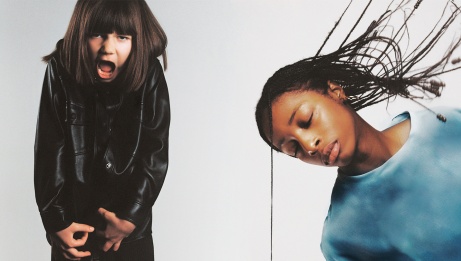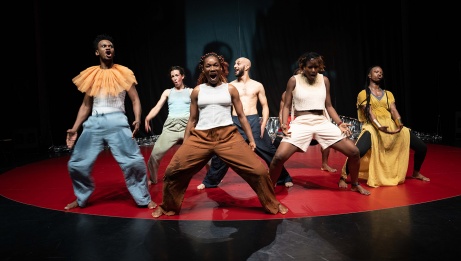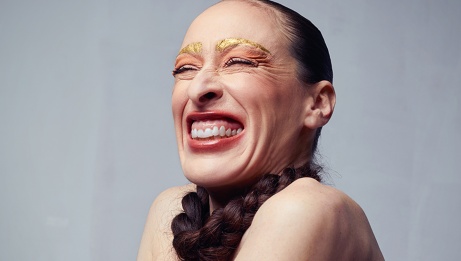Paul-André Fortier entered the world of dance in the 1970s. As a member of Groupe Nouvelle Aire, one of the country’s most innovative choreographic ensembles, he, along with other exceptionally creative artists in the group, contributed to building the reputation of Quebec dance from the 1980s until today.
Fortier first distinguished himself as a dancer. A “natural” dancer - as self-taught dancers were described at the time - he was known for his strong stage presence and elegant, refined interpretations. He soon became a leading figure on the Montreal dance scene, then on the Canadian stage, a position he has retained. He was involved in all of the innovative projects at the time, with his mentors (Martine Époque and especially Françoise Sullivan, whom he called his “artistic mother”) and his peers (including Edouard Lock and Daniel Léveillé), who began to create their own works, as did he.
Fortier’s career as a choreographer had an immediate and significant impact on the dance landscape. He was known for “inventing” new concepts that differed in both form and content (if one can be dissociated from the other), beyond the scope of tradition and convention. Very early on, he became the forerunner of a style, recognized by his peers, that used theatricality to draw attention to the stresses and tensions of the modern world, with intense, determined and rigorous form. During this period, he was one of the first to lead the way toward a style of dance freed from the constraints of the past, inspiring a whole generation of choreographers to be open to modernism and creative risk.
This is a risk that Fortier has always been willing to take. Never one to use set formulas in his choreography, he has always been an “art adventurer” (in the truest sense of the word), for whom creating means stepping into the unknown, into the void. After experiments with dance theatre that left an indelible mark on choreographic practices in Quebec in the 1980s, he embarked, in grandiose fashion, on a solo adventure with a trilogy* accompanied twice by Betty Goodwin. Following that decisive encounter with a world rich in form and symbolism, the choreographer-performer returned to the very basis of dance: movement itself, culminating in Tensions and Lumière.
While aware of developments on the current art scene, particularly with the advent of multimedia and new technologies, Fortier does not blindly follow contemporary trends and today’s penchant toward “everything technological.” On the contrary, he has carefully calibrated the symbolic and aesthetic scope of his projects, notably in Tensions and Spirale, a choreography for 12 dancers created for the Ballet de Lorraine, in Nancy, France.
In 2006, he broke new ground with Solo 30x30, which has stood the test of time as a performance and physical feat. This piece, performed outdoors, has taken him around the world, from London to Rome, from Nancy to Ottawa, Montreal, Bolzano, Yamaguchi, Newcastle, Lyon, Vancouver, Liège, New York, Lorient and Paris. This ritual played out for thirty consecutive days, rain or shine, for passersby who stop to watch - or who don’t - is an act of humility that I personally find astonishing. This unique experience has also inspired many artists in the countries he has visited: videographers, photographers, composers, and even writers at the International Literature Festival held in Montreal in 2011.
From his very first solos, Paul-André Fortier has collaborated with other well known artists, including visual artist Pierre Bruneau, composer Alain Thibault, Japanese artist Takao Minami, lighting designer John Munro, filmmaker Robert Morin and writer-performer Rober Racine. With the latter three, Fortier created Cabane, which premiered at the TransAmériques Festival (FTA) in 2008, then toured Canada and Europe. This was followed by Vertiges in 2012, an unusual and poignant duet with improvisational violinist and composer Malcolm Goldstein: two men, both mature artists, sharing a single creative path. This unlikely duet was followed by Misfit Blues (FTA 2014), a wacky, zany little theatrical piece created and danced with choreographer-performer Robin Poitras, on a set designed by Edward Poitras.
Nearly 40 years have passed since Derrière la porte un mur, and more than 50 choreographies. Paul-André Fortier is now concerned about passing his legacy on to future generations. He is restaging Bras de Plomb with Simon Courchel, offering him 15 X AT NIGHT, a kind of night-time version of Solo 30x30. He is dancing in the Pluton 2 project, a solo by Frédérick Gravel. While he is involved in writing and publishing the Testament artistique, an artistic legacy for the dance community, he is still involved in creative projects for the future, looking ahead to celebrating his 70th birthday. Stay tuned…..
Michèle Febvre
Paul-André Fortier est né à la danse dans les années 70 au cœur même de l’une des aventures chorégraphiques les plus novatrices du Québec et du Canada, celle du Groupe Nouvelle Aire où se sont retrouvées les personnalités créatrices les plus marquantes qui, avec lui, ont bâti la renommée de la danse québécoise des années 80 jusqu’à aujourd’hui.
Rappelons qu’avant même de chorégraphier, il s’est distingué immédiatement comme danseur. Danseur « naturel » – comme on appelait à l’époque ceux qui savaient danser sans l’avoir appris–, élégant, racé et raffiné, interprète à la forte présence scénique, qui est devenu rapidement une figure incontournable de la scène chorégraphique montréalaise puis canadienne et l’est resté. Il a été de tous les projets novateurs de cette période, ceux de ses maîtres (Martine Époque, mais surtout Françoise Sullivan qu’il appelle sa « mère artistique »), ceux de ses pairs qui, comme lui, commencent à créer (Édouard Lock et Daniel Léveillé, entre autres).
Son parcours de chorégraphe fut d’emblée significatif dans le paysage de la danse. Significatif par « l’invention » de propositions nouvelles tant dans leur forme que dans le contenu (si tant est que l’on puisse dissocier l’un de l’autre), à l’écart de la tradition ou des modes convenues. Il est le précurseur, très tôt reconnu par ses pairs, d’une théâtralité chorégraphique qui affichait haut et fort les tensions du monde contemporain dans une forme drue, exigeante et rigoureuse. Il est ainsi l’un des premiers de cette période à avoir tracé la voie d’une danse libérée des formes du passé qui fit ensuite les beaux jours de toute une génération de chorégraphes ouverte à la modernité et au risque créateur.
Et ce risque, il a toujours su le prendre lui-même. Fortier, en effet, n’est pas un chorégraphe de recettes mais bien un « aventurier » de l’art (au sens noble du terme), pour qui créer est toujours un pas dans l’inconnu. Après une danse-théâtre branchée sur le monde et qui a profondément marqué l’imaginaire et la pratique chorégraphique québécoise des années 80, il a tenté, de façon magistrale, l’aventure du solo, avec une trilogie* à laquelle s’est jointe, par deux fois, Madame Betty Goodwin. À partir de cette rencontre d’univers formels et symboliques riches, le chorégraphe-interprète a renoué avec la matière même de la danse, le mouvement, qu’il portera à son apogée notamment dans Tensions et Lumière.
Toujours attentif à ce qui se passe en art aujourd’hui, notamment l’avènement du multimédia et des nouvelles technologies, le chorégraphe n’a pas cédé aveuglément aux caprices de l’époque, à la vague du « tout technologique », au contraire, il en a mesuré la portée symbolique et esthétique, déjà pour Tensions puis pour Spirale, une chorégraphie pour douze danseurs créée pour le Ballet de Lorraine à Nancy.
En 2006, il avait relancé les dés pour le projet Solo 30X30 qui a tenu de l’épreuve initiatique, de la performance et de l’exploit. Ce travail hors les murs l’a mené de Londres à Rome, en passant par Nancy, Ottawa, Montréal, Bolzano, Yamaguchi, Newcastle, Lyon, Vancouver, Liège, New York, Lorient et Paris. Ce rituel accompli par tous les temps pendant 30 jours pour des passants qui s’arrêteront ou non est une action d’humilité qui, personnellement, me confond. De plus, cette expérience unique a inspiré de nombreux artistes des pays visités : des vidéastes, des photographes, des compositeurs et, en 2011, des écrivains lors du Festival international de la littérature de Montréal.
Depuis ses premiers solos, Paul-André Fortier a privilégié des collaborations avec d’autres créateurs majeurs, entre autres l’artiste visuel Pierre Bruneau, le compositeur Alain Thibault, le plasticien japonais Takao Minami, le concepteur d’éclairage John Munro, le cinéaste Robert Morin et le performeur écrivain Rober Racine. Les trois derniers ont d’ailleurs fait partie du projet Cabane présenté en première au Festival TransAmériques (FTA) en 2008, puis en tournée au Canada et en Europe. Puis ce sera la création de Vertiges en 2012, un duo insolite et poignant avec le violoniste improvisateur et compositeur Malcolm Goldstein : deux hommes, artistes de maturité, partageant leur chemin de création. Ce duo improbable sera suivi de Misfit Blues (FTA 2014), œuvre loufoque, un rien déjantée et grinçante qui renoue avec une certaine théâtralité, créée et dansée avec la chorégraphe interprète Robin Poitras dans une scénographie de Edward Poitras.
Presque 40 ans depuis Derrière la porte un mur, plus de 50 chorégraphies. Paul-André aujourd’hui se fait passeur, s’inquiète du patrimoine, du legs aux générations futures. Il remonte Bras de Plomb avec Simon Courchel, lui offre 15 X LA NUIT, sorte de version nocturne de Solo 30x30. Il danse dans le projet Pluton 2 un solo de Frédérick Gravel. Il s’implique dans la réalisation et la publication du Testament artistique destiné à la communauté de la danse, mais ne lâche pas la création. En devenir, des projets pour ses 70 ans. À suivre…
Michèle Febvre









